For retailers looking to diversify their product lines, now is the time to consider personalizing products that hover just outside the traditional boundaries of the awards and recognition market. Sandblasting, commonly known as sandcarving, is an easy-to-learn, creative, and profitable way to tap into new and
burgeoning markets, including personalization and gifts, memorialization, and architectural design, say several industry experts.
Sand Dollars
New Sandcarved Products Can Be Your Blue Ocean Strategy
By Jane Martinsons
(Originally published in the June 2015 issue of Recognition Review.)
For retailers looking to diversify their product lines, now is the time to consider personalizing products that hover just outside the traditional boundaries of the awards and recognition market. Sandblasting, commonly known as sandcarving, is an easy-to-learn, creative, and profitable way to tap into new and burgeoning markets, including personalization and gifts, memorialization, and architectural design, say several industry experts.
Before discussing new markets, however, it’s necessary to ditch any preconceived notions of sandcarving as dirty, messy, or difficult to master, say prominent sandcarving-equipment suppliers. Times have changed, say Liz Haas, sales representative, and Billy Willis, sales manager, both of Rayzist Photomask, Inc., in Vista, CA. Unlike 30 years ago, when sandcarving involved hand-sifting sand and emptying pressure pots, today’s process is very clean, self-contained, and efficient. “Sandblasting is so easy that anybody can do it. It’s not complicated,” Willis said. “With it, you’re able to achieve just amazing detail and resolution with virtually anything.”
Even the term sandcarving is a misnomer because sand doesn’t play any part in today’s sandcarving process, at least not domestically, said Peter Norman, corporate accounts manager at IKONICS Imaging in Duluth, MN. “To decorate any substrate now, you use a silicon carbide or aluminum oxide (as) a grit,” which is safe, he said. “You can become an expert in basic sandblasting relatively fast,” in as little as a couple of days, he said.
MARKET TRENDS
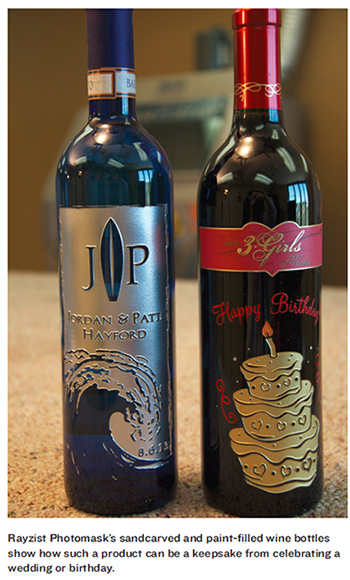 That said, trends ranging from an improving economy to new technologies and a host of new products are fueling growth in sandcarving markets. Even in the established glass-and-crystal awards market, an improving economy is spurring resurgence in sandcarved bowls, vases, and other awards as companies work harder to recognize and retain good employees in opening job markets.
That said, trends ranging from an improving economy to new technologies and a host of new products are fueling growth in sandcarving markets. Even in the established glass-and-crystal awards market, an improving economy is spurring resurgence in sandcarved bowls, vases, and other awards as companies work harder to recognize and retain good employees in opening job markets.
“In the past few years, when the economy was bad, we saw a decline in corporate orders because companies see awards as a luxury and not a necessity. They are the first to be cut from a budget,” said Jean Chen of Crystal by Design, Co., Inc., in El Monte, CA. “But slowly we are seeing an improvement, and hopefully that trend will continue. We feel that it is important to reward people for their efforts and achievements. In the long run, it pays for itself in motivation and productivity.”
Greg Rice of Topmost World, Inc., in Montclair, CA, agreed. “With the economic downturn, many companies were cutting out their recognition programs or going as cheap as possible. But with the economic resurgence, companies are focusing more on structured recognition programs,” he said, “and sandblasting is playing a big part.”
An improving economy also means that individual consumers can afford to spend on personalized gifts and accessories. “Weddings and anniversaries have always been big gift markets for sandblasting personalized gift items,” Rice said. “In the last year, gift items such as flutes, picture frames, and ornaments, including sun-catchers and crystal keychains, have been really pretty big for us.”
The same is true for corporate gifts, said Rice, whose corporate clients are distributing sandcarved ornaments with company logos or event dates at gatherings and as promotional pieces. “Everyone is big into personalization of gift products,” he said, “and I think that the personal gift market is really something that’s going to be a big push in the future.”
MORE PRODUCTS THAN EVER
Both Norman and Willis agreed with that prediction, but cite other growth sectors in sandcarving, such as memorialization and architectural detailing, and note that more products are available in these sectors.
“The sandblasting markets have really widened over the past 8–10 years because there are just more products available on the market,” Willis said. “This is unlike many years ago, when (sandcarving) was just limited to awards, such as engraved plaques, and other recognition-type products. Particularly in the gift market, there’s a whole line of personalization products today,” he said, citing the increased popularity of personalized picture frames, toasting glasses, and leaded crystal vases and bowls.
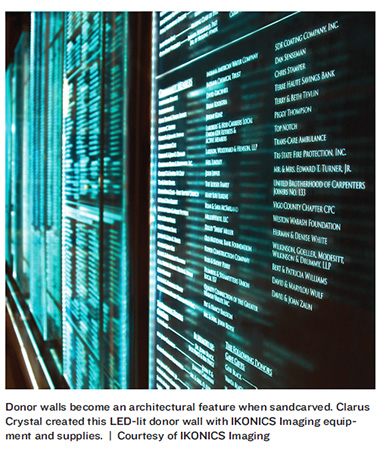 Willis further noted that the memorialization market is growing as remembrance objects move from the cemetery to the home in the form of glasses, bowls, vases, jewelry boxes, and unique pieces of jewelry reminiscent of old-fashioned mourning lockets. Today, for example, a memorial sculpture or piece of jewelry may be made of art glass mixed with the cremation ashes of a loved one or a pet, he said.
Willis further noted that the memorialization market is growing as remembrance objects move from the cemetery to the home in the form of glasses, bowls, vases, jewelry boxes, and unique pieces of jewelry reminiscent of old-fashioned mourning lockets. Today, for example, a memorial sculpture or piece of jewelry may be made of art glass mixed with the cremation ashes of a loved one or a pet, he said.
Norman says that a growing number of markets beyond awards and recognition are using both decorative and photo-resist sandblasting, including the personalization and gift market, the signage market, donor-wall recognition, and architectural design. Among these, he sees the fastest growth is in the personalization/gift and architectural markets.
“The personalization is pretty broad; you can personalize just about anything,” Norman said. “The area where (sandcarving) really shines is with brittle substrates—anything from ceramic to glass, marble and wood. As far as new markets, any market that has a need for decorating or personalizing substrates can utilize decorative sandcarving.”
Those who spoke to Recognition Review point to several popular sandcarved products, including:
Stemware and wine bottles: Monogrammed stemware is making a big comeback among corporate and individual clients alike, Willis said. Couples getting married are “branding” their toasting glasses and wine bottles with intertwined initials or family crests—sometimes as part of a package of monogrammed napkins, matchbooks, and party favors.
Meanwhile, corporate clients large and small, as well as individual customers, are sandblasting logos and other types of branding on glassware and coasters. Willis said that the trend is seen just as much among home-based “man-cave” bars as microbreweries and home-retail stores such as Williams-Sonoma.
In the past year, Topmost World has begun to carry champagne glasses and goblets, but mostly for individual customers rather than restaurants, Rice said. The company’s latest line features nonleaded European crystal bowls, vases, and glasses, which he says serves as a less expensive alternative to the traditionally large, leaded crystal trophy vases.
Art glass: Whether hand-blown, flat, or fused, art glass is making big gains in both the memorialization and awards and recognition markets, Willis said. He increasingly sees monogrammed or multicolored, hand-blown glass bowls and plates, as well as fused-glass awards featuring seemingly three-dimensional text or images.
Architectural design elements: Architectural sandcarving offers timeless, weather-resistant images with a high-perceived value, Norman said. “The return-on-investment with large-scale, halftone, and multilevel carving projects make for a very profitable job. One of our customers sandcarved a Rocky Mountain halftone for a celebrity mansion in Denver, CO, while another customer in Ontario, Canada, created a helicopter cockpit in a bar. The controls, gauges are a stage-carve blast on the front and back of the glass. The more glow in the image the deeper the area was sandcarved. The skyline is a 45 dpi halftone etched on the backside giving the image a three-dimensional feel.”
Despite these trends, suppliers of glass and crystal awards note that their bread-and-butter, big-ticket orders continue to come from retailers buying awards for corporate clients and professional or college sports teams—not from personalized gifts.
“For now our main focus is recognition products because this is what is in most demand,” Chen said. “Most recognition programs give out awards on an annual basis, so you already have a repeat customer in that sense. We do carry some gift-related products, such as wine-bottle stoppers, vases, and jewelry boxes, which can be used for a variety of occasions. (However), there isn’t a huge demand for these,” she said, stressing that personal gifts make up Crystal by Design’s smallest market.
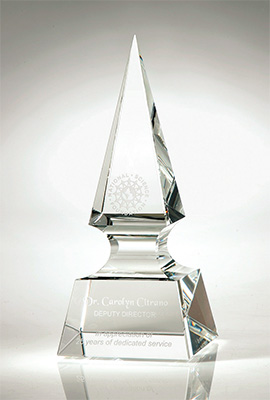
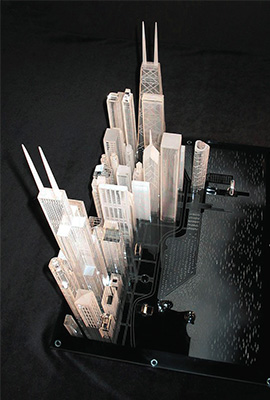
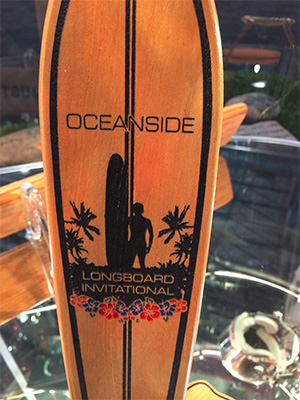
Even when creating awards, retailers can think outside of the box to incorporate sandblasting. Sandcarve multiple surfaces of a crystal clear piece as Crystal by Design did with the award on the far left. Riordan Artistry created the amazing skyline, complete with sandcarved skyscrapers at center (photo courtesy of IKONICS Imaging), and sandblasted wood became a tubular surf souvenir in the hands of Rayzist Photomask.
TIPS FOR SANDCARVING
For those considering sandcarving, these suppliers say to:
Allow for learning and prep time. Despite suppliers’ emphasis on ease of learning, Chen notes there is still a learning curve involved with sandblasting. “With experience comes skill,” she said, so “take your time and figure out what method works best for you. For example, getting the right exposure time on the film is critical, but it will depend on the type of film you use and the level of intricacy of the artwork. Always follow the manufacturers’ recommended exposure times, but also calibrate the right balance for you,” she said.
“You will also need to figure out what washing method is best for you,” Chen said. “For our small operation, we use a power washer because we feel it is the most efficient and can wash films quickly. However, the force of a power washer can also blow parts of the film away if you’re not careful. Obviously, there are many pros and cons to each method—and a lot of trial and error in the beginning—so be sure to ask vendors to donate chipped or defective products that you can practice on.”
Likewise, Rice recommends that retailers “start small, start slow, and practice using samples before jumping into a $150 piece. Several times we have had customers call us about (big) mistakes and we’ve had to reorder the product.” Likewise, Norman suggests that when working with images, start with simple ones and work your way up to half-tone photographs.
Stick with what you know. “We always tell clients not to go too far away from their niche,” Norman said. ”If it’s working for you, stick with what you’re good at. It’s what your customers are buying.” For example, he says, if you’re already working with sublimated mugs, try sandblasting ceramic mugs.
Understand the perceived value of deep etching. Sandblasted glass and crystal have the highest perceived value in the marketplace, so never underestimate the value of your craft, Willis said. “It is a hand-produced item, so do not undervalue the product and what you’re creating.”
Because they are handcrafted, sandcarved products should be marketed for their quality, Norman said. He and others recommend that retailers go out of their way to show customers the high-quality, deep etching of sandcarved products.
“When you’re dealing with crystal and glass, sandblasting is really that extra step that makes a piece stand out, and (allows for) a recognition experience,” Rice said. “I tell corporate clients that if this is something they really care about, then it’s worth the extra money to make it count and give an impact. With personal gifts as well, (it says that) you’re giving something meaningful. It makes a statement about your relationship.”
Try new substrates. Willis said that there’s a world of substrates other than glass, including stone for floor or wall donor recognition and memorialization. Likewise, Norman said “you can sandblast anything that’s brittle—glass, stone, ceramic, granite, marble—with a very deep and permanent etch. When you use other engraving methods with a brittle substrate, it’s harder to get that.”
But there are limitations to choosing substrates. Plastic, resins, and inexpensive plated metal are not ideal for sandcarving, Willis said. Although sandcarving can remove polished or coated surfaces, it cannot actually permeate these substrates to create deep engraving. Likewise, tempered glass will be compromised with deep etching, he said.
Regardless of the substrate, Chen and Rice say it takes skill to achieve detailed or intricate designs with sandcarving. “Obviously, there’s a lot of pressure going on when you sandblast,” Rice said. “You’re moving (the piece) around a lot so you want to be careful not to ding or chip it, and you want to make sure that the film is applied properly. If you have a detailed image, you risk blowing out a chunk of your artwork and having to reorder the product.”
Follow your passion. Willis stresses that “the people who succeed in this market are those who have really creative design in their work and in their etching. Find what you love to do. Once you love to do something and find your niche, whether wine bottles or the entire bridal industry, you’re able to sell your work a whole lot easier.”
Know washing instructions. Heat and industrial washing won’t harm etched items, but painted or color-filled designs should be hand washed.
Express yourself! “The medium allows you to be expressive and creative without necessarily being highly artistic,” Willis said. “There are no rules in sandcarving; no particular rights or wrongs. It’s very much a hand-produced, hand-created item, so it lends itself to the expressive side of people.
“He adds, however, that those with limited artistic abilities should “surround themselves with good creative art-type people, or people who understand tools or programs such as Illustrator or Corel,” he said. “If you don’t have that skill set, then you need to surround yourself with people who do.”
Follow your passion. Willis stresses that “the people who succeed in this market are those who have really creative design in their work and in their etching. Find what you love to do. Once you love to do something and find your niche, whether wine bottles or the entire bridal industry, you’re able to sell your work a whole lot easier.”
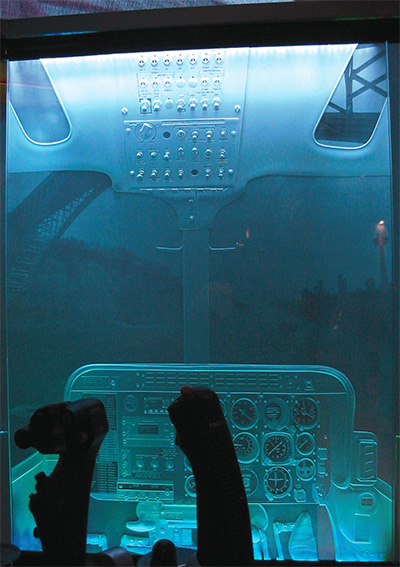
An IKONICS Imaging customer in Ontario, CA, created this sandcarved helicopter cockpit at a bar. “The controls, gauges are a stage-carve blast on the front and back of the glass. The more glow in the image the deeper the area was sandcarved. The skyline is a 45 dpi halftone etched on the backside giving the image a three-dimensional feel,” said Peter Norman of IKONICS Imaging.